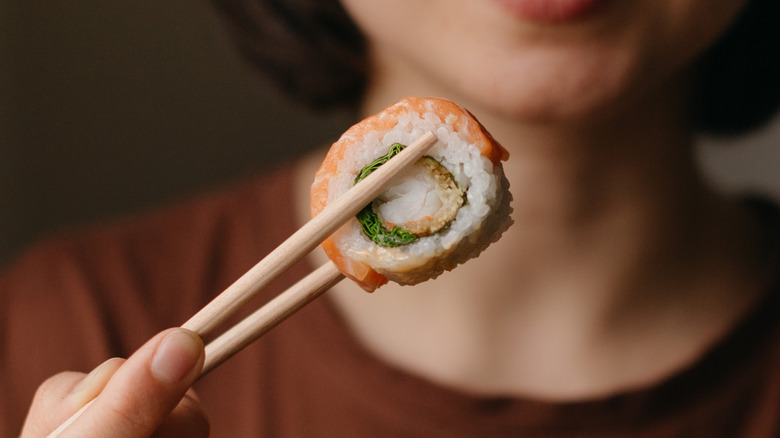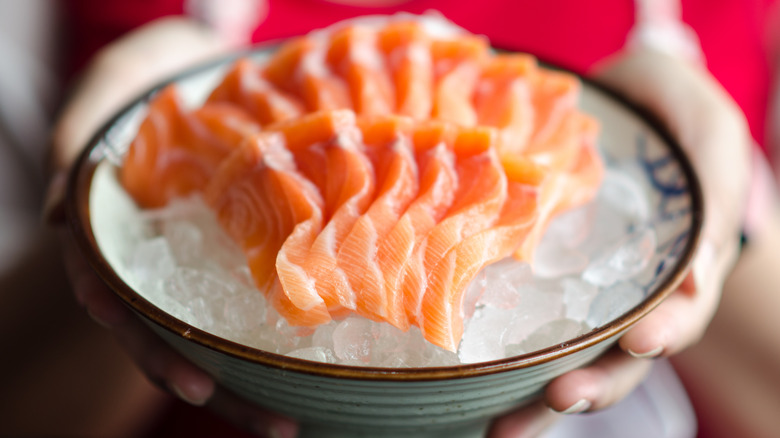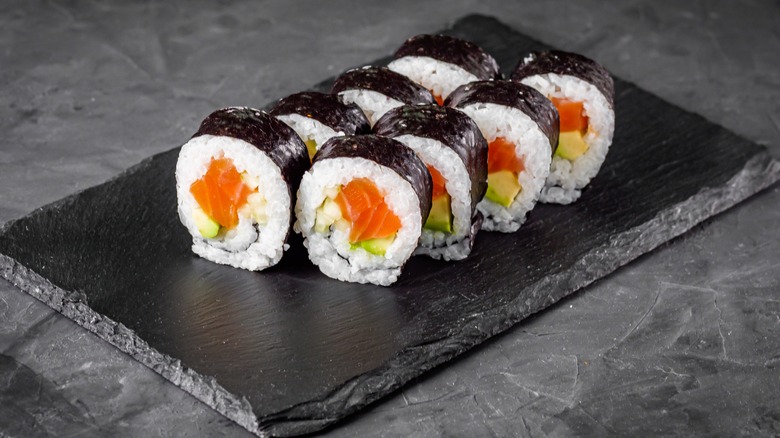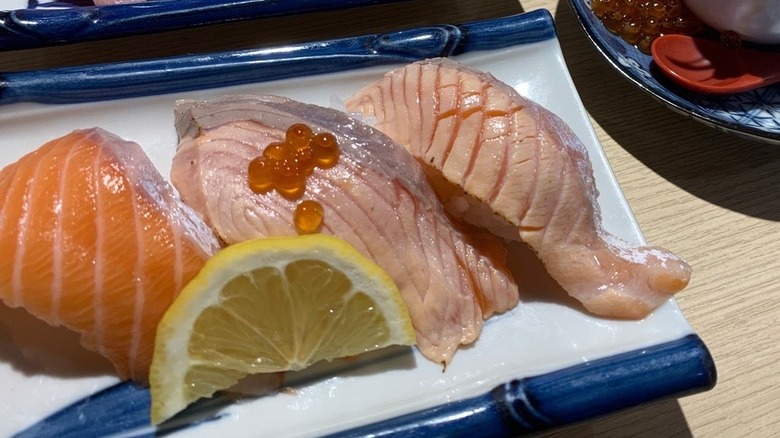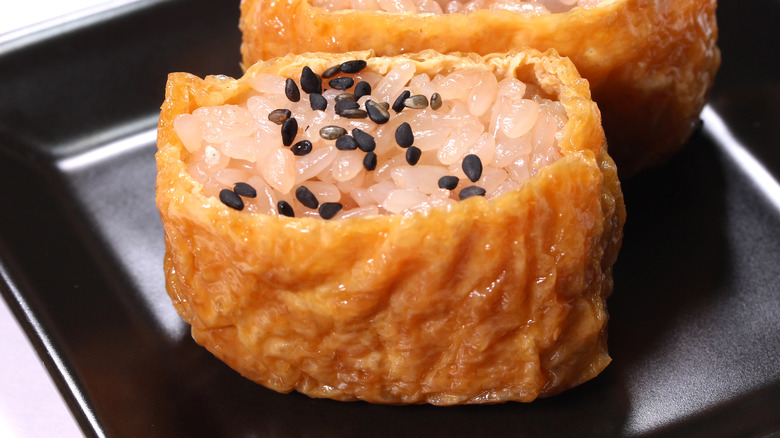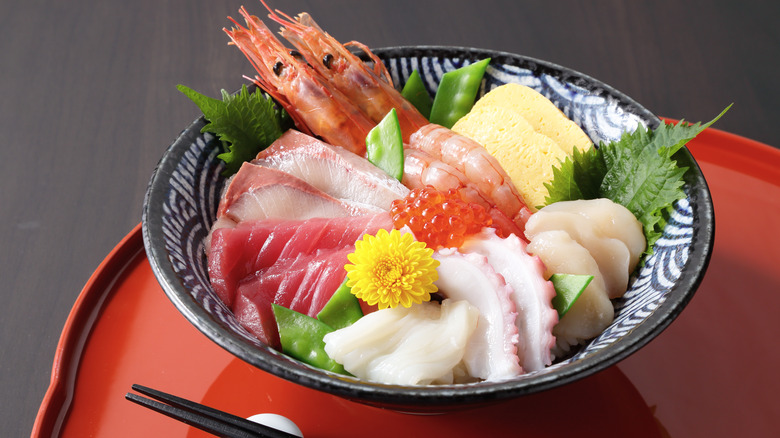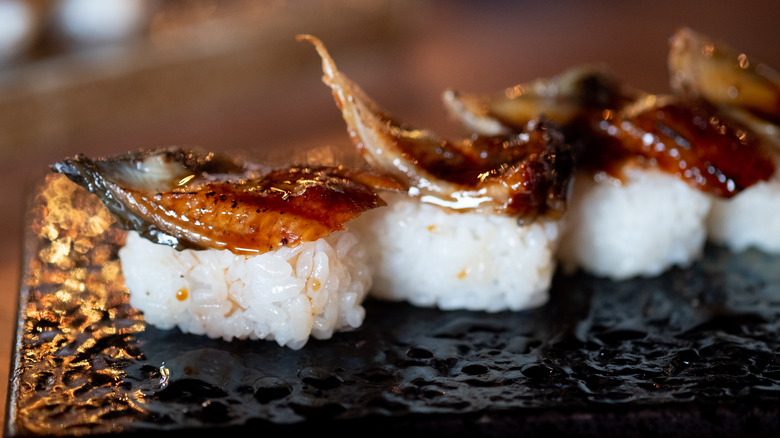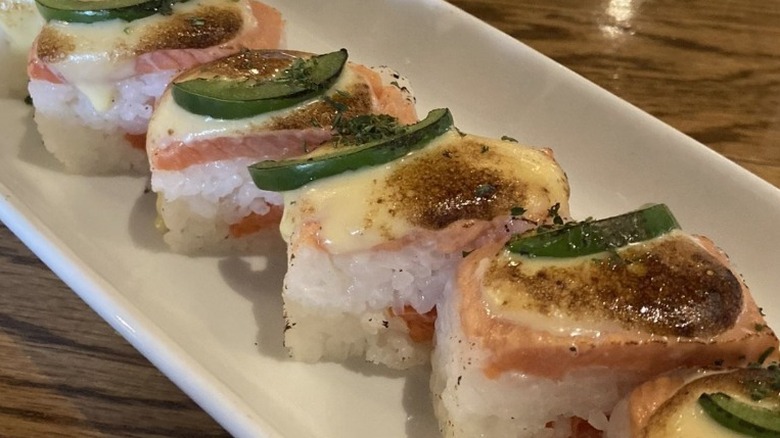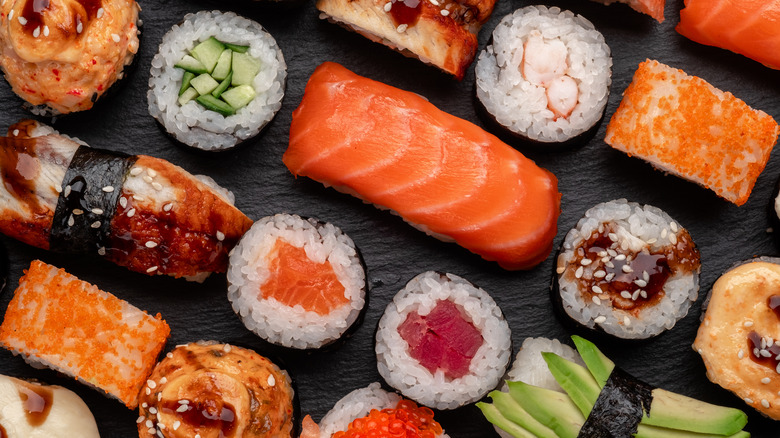The Ultimate Guide To All 6 Different Types Of Sushi
Visit any sushi bar and you'll see that there are multiple types of sushi — all with different ingredients, names, beautiful presentations, and delicious flavors. As Business Insider noted in a 2015 piece on the history of sushi, it has become a widely recognizable food loved by many across the globe for nearly a century, though its origins in Japanese culture date as far back as the third to fifth century B.C. The dish has also changed significantly since its original iteration, transforming from simple pickled fish and rice to more elaborate and decadent bite-sized rolls.
Although we tend to name spider rolls, California rolls, and spicy tuna rolls among the different types of sushi we love most, these aren't technically actual sushi categories. Luckily, this guide will dive deep into the six taxonomical categories of sushi — chirashizushi, inarizushi, makizushi, narezushi, nigirizushi, and oshizushi — in order to explain what kind of ingredients each one typically includes, and how they all differ from one another. We'll also cover a few popular variations of these primary categories, so you can feel like a true expert the next time you go out on the town for some sushi-filled dining.
1. Sashimi is not technically the same as sushi
First, let's clear up a common misunderstanding: Sashimi and sushi are not the same type of dish. These two terms are often confused for one another, but in reality, they are two distinct, separate types of foods in Japan, where they both originated. While sushi requires different ingredients to be paired with rice to create those yummy bites of fish, veggies, and flavor, sashimi refers only to raw fish. According to Benihana, the word sashimi roughly translates to "pierced body." (Considering that sashimi is thinly sliced pieces of fish, like tuna or salmon, the term is pretty apt.) You might see sashimi prepared on a bed of daikon — or presented all by itself — rather than atop rice, or wrapped in a sushi roll, per The Pioneer Woman. So, in summary, sushi can contain sashimi, but sashimi is not a type of sushi.
Perhaps most important to those eating sashimi is food safety. Since sashimi is always raw, it's crucial to know where its primary ingredient (i.e., fish) is sourced from, along with how it's prepared. To be categorized as sashimi, the fish must meet several requirements, all of which indicate its safe for consumers to, well, consume. According to the North Carolina State University Seafood Laboratory, a passing grade for sashimi-grade tuna depends on the fish's biology, such as sex, age, and health. It also requires safe fishing, handling, and chilling techniques, like quickly lowering the fish's temperature and packing it with ice until it reaches its destination.
2. Makizushi is probably the sushi you know best
When you think of the sushi you love to eat, or arrays of sushi scattered across Instagram in gorgeous, stylized photos, you're probably thinking of makizushi. Also referred to as norimaki or maki, makizushi is one of the most common types of sushi. Generally, this sushi type is made by rolling the ingredients into long rolls and slicing them to create bite-sized pieces, which are either eaten by hand or with a pair of chopsticks (via Benihana).
That being said, makizushi isn't just a catch-all term for any kind of sushi roll — rather, it specifically references sushi rolled with seaweed on the outside and rice on the inside. According to sushi expert and renowned chef Niki Nakayama, we can further break down maki into four categories: uramaki, temaki, futomaki, and hosomaki (via MasterClass). Uramaki is maki in reverse, like the California roll, which features rice on the outside rather than seaweed. Temaki is rolled into a cone-shaped and is larger than traditional maki, making it more of a hand food than one to eat with chopsticks. Futomaki is a thicker version of maki, translating to "fat roll" in English. Finally, hosomaki is the opposite of futomaki; its name means "skinny roll" in Japanese, and it features one or two ingredients in addition to rice.
3. Narezushi is commonly thought of as one of the first types of sushi
Narezushi, also called nare sushi, may not be one of the most popular types of sushi to eat today – but it's also thought of as one of the first known versions of the popular food. Speaking with Business Insider in 2015, Los Angeles-based cooking instructor and sushi expert Yoko Isassi explained that narezushi was simply "pickled fish and rice, which would be left in a barrel for a year and weighed down by a heavy stone." As a result of the fermentation process, narezushi was considered a dish ripe with pungent flavors that many probably wouldn't love today. Usually, the fish used to make narezushi was more than what was needed, so the pickling process prevented food waste. However, people ate only the fish portion of narezushi, with the rice portion removed.
Though narezushi might be considered by many to be an acquired taste, there are plenty of people who continue to keep the culinary tradition of preparing and eating it alive, per CNN. A number of them hail from or live in the Lake Biwa region of Japan, where narezushi is still served — but with a modern twist that incorporates rice. (Narezushi holds a high place of importance in Japanese food history; in fact, it may have actually been the progenitor of nigiri, a popular type of sushi with fish that sits on a bed of rice.) Many hang onto the tradition and history of narezushi by passing down recipes through generations of family.
4. Inarizushi blends sushi and tofu
Inarizushi is a unique type of sushi with a name that refers to sushi fried in tofu pouches, resulting in a pocket-like shape that's full of flavor. If the idea of crispy fried outer edges and traditional sushi flavors intrigues you, then inarizushi is a must-try.
According to Niki Nakayama's intro to sushi on MasterClass, inarizushi is named after Inari, the Shinto god of agriculture; per Shinto tradition, a popular offering for Inari was aburaage, the tofu pouches used in inarizushi. Historically, aburaage usually was only stuffed with rice, a method that's still sometimes used today. However, modern inarizushi can also take on many forms, featuring ingredients like soy sauce, nori, or sesame seeds.
Pastry chef Patrick Lemesle uses sakura, the cherry blossoms Japan is well-known for, to brighten his dishes in unique ways (via Le Cordon Bleu). In fact, he says that using sakura in inarizushi and other dishes adds sweetness to otherwise salty dishes. Lemesle also pickles sakura to add a touch of sweetness to inarizushi.
5. Chirashizushi puts sushi in a bowl
It can take a long time to perfect sushi rolls just like the pros do it — and not even the pros get it right all the time. "Sometimes I cry, but only when I'm at home on my own," Tetsuya Sakurai, a sushi chef in training, told Business Insider in 2015 in reference to the difficulty level of preparing sushi. However, it's possible to get all the flavors of sushi without the hassle of rolling sushi ingredients into tidy rolls. All you have to do is opt for by opting for chirashizushi instead.
Chirashizushi, or chirashi sushi, means "scattered sushi" in English. Traditionally a favorite for birthday celebrations and the Japanese holiday Hinamatsuri, chirashizushi is essentially deconstructed sushi served in a bowl or on a plate, per the Japan-America Society of Washington, DC. According to Tomoko Imade Dyen, a restaurant marketing director and consultant who works with various Japanese-style eateries across the U.S., the seemingly simple presentation of chirashizushi isn't actually simple at all. "With great chirashi, there are so many little differences that the average customer might not notice — from the type of rice that is used to how the fish is cut. It's not as easy as putting raw fish on top of rice," Dyen told the Los Angeles Times in 2020.
6. Nigirizushi is a more simplified rice and fish dish
Some experts split sushi into two primary categories: makizushi and nigirizushi. While maki is rolled and sliced into separate pieces, nigirizushi — also called nigiri — features thinly sliced sashimi laid on top of a small pile of rice. Often, the fish is raw, but it's not uncommon for nigiri to include shrimp, eel, or other cooked fish (via Benihana).
New York sushi chef Daisuke Nakazawa studied as an apprentice underneath Michelin-starred sushi artist Jiro Ono — the same chef featured in the acclaimed 2011 documentary "Jiro Dreams of Sushi." In a YouTube video for the web series "First We Feast," Nakazawa breaks down the essential steps for getting nigiri just right. His most important rule? If you're making nigiri, you need to use seafood that's in season, and to use fresh ingredients overall. (This also serves as a nod to Japanese culture, per the chef.) Nakazawa also says that nigiri has ten crucial steps to master, including dipping his fingers in water before assembling the sushi, which prevents the rice from sticking to his hands as he molds it into the correct shape.
7. Oshizushi looks like cake
The last type of sushi on our list is oshizushi. Made in layers of pressed rice and other ingredients that, when formed together, resemble a cake, oshizushi is a bonafide feast for the eyes and perfect to serve at parties or a get-together of any stripe. As Umami Insider notes, oshizushi isn't as quite as popular in the U.S. as it is in Japan, though it may be gaining ground. According to chef Naoko Kashiwagi of Naoko's Kitchen, oshizushi ingredients vary in different areas of Japan, as each region tends to cook with its native ingredients. However, chefs usually prepare oshizushi in a similar way — namely by using a sushi mold that helps hold and shape the ingredients together, starting with the toppings placed on the bottom, and working through layer-by-layer from there.
Sasa-zushi, a unique form of oshizushi, uses a similar form of layered ingredients, but with bamboo leaves stealing the show as its own layer of the dish. According to the official travel guide Enjoy Niigata, bamboo was historically thought to be a convenient way to serve food to members of the military or other groups on the mode, an alternative to vessels or accouterments like bowls. Like traditional oshizushi, sasa-zushi can also include many different components, like salmon, bamboo shoots, and stripped omelet.
8. Types of sushi, in summary
If you've made it to this point in the article, congratulations — you can now easily impress your friends by explaining how each type differs from one another or pointing out each kind of sushi from an assorted platter. (You're welcome.) However, there are virtually endless ways to make each kind of sushi, depending on how creative a chef feels like being.
As you've probably inferred at this point, all the sub-categories of each type of sushi make for plentiful options when it comes to seeing what you like most. In fact, one of the reasons that sushi became so popular in the United States is because of its ability to ride the wave of health-conscious food trends and incorporate healthy ingredients so easily (via Mental Floss). In this way, sushi is able to become what consumers want using ingredients they know and love with a wide-open door for experimentation. If you're in the mood to try something new in the world of sushi, head to a popular sushi restaurant near you.
